Introduction
The journey of understanding autism has been a long and evolving one, marked by significant shifts in perception and classification. Initially misunderstood and misclassified, autism was once thought to be a form of childhood schizophrenia, leading to widespread stigma and isolation for many families. Over the decades, this view has transformed, recognizing autism as a complex, multifaceted neurodevelopmental disorder that manifests in a spectrum of symptoms and severities.
Today, autism is classified into three levels based on the degree of support needed, ranging from minimal to very substantial. Each level presents unique challenges and requires tailored interventions to enhance the quality of life for individuals and their families.
The importance of early diagnosis and personalized interventions cannot be overstated. Timely identification and appropriate support can significantly improve social communication skills and overall development, particularly when interventions are integrated into daily routines. However, the journey does not end with diagnosis.
Securing the right resources and support remains a significant challenge, often compounded by barriers such as lack of access to specialized services and societal misunderstandings about neurodiversity.
This article delves into the historical perspective of autism classification, the current understanding as outlined by the DSM-5, and the specific characteristics and support needs across the three levels of autism. It emphasizes the critical role of early and personalized interventions, and the ongoing efforts to improve the outlook and quality of life for individuals with autism and their families. By shedding light on these aspects, the article aims to empower parents and caregivers with the knowledge and resources needed to navigate the complexities of autism, advocating for a future where every individual can thrive.
Historical Perspective: Previous Classifications of Autism
The comprehension of the condition has progressed notably over the years. 'Initially, the condition was mistakenly classified as a form of childhood schizophrenia, largely due to its association with self-absorbed thinking as described by Swiss psychiatrist Eugen Bleuler in 1911.'. This early misclassification contributed to widespread stigma and misunderstanding, leaving many families feeling isolated. During the 1960s and 1970s, the perception of this disorder began to shift towards recognizing it as a neurodevelopmental condition. Major progress in the 1980s and 1990s resulted in the acknowledgment of this condition as a spectrum disorder, including a broad array of symptoms and intensities. This shift was crucial in refining diagnostic criteria, which now emphasize challenges in social communication and interaction, as well as restricted and repetitive behaviors. Today, this condition is understood as a complex, multifactorial neurodevelopmental disorder with a strong genetic component, although research into its precise causes continues. This journey from early misclassification to a nuanced appreciation of the spectrum of conditions reflects broader changes in psychology, psychiatry, and societal attitudes towards mental health and neurodiversity.
Current Understanding: The Three Levels of Autism
Autism is acknowledged as a spectrum condition, characterized by differing levels of assistance requirements. The DSM-5 classifies this condition into three levels: Level 1, Level 2, and Level 3, each indicating the extent of support a person needs, ranging from minimal help to very substantial aid. This classification is essential for parents and professionals as it provides guidance on the types of support and resources needed for each individual.
The DSM-5 criteria necessitate that the essential characteristics of the condition be evident in early childhood, although signs may not completely appear until interpersonal demands surpass the individual's ability to manage. Autism generally becomes evident by age three, although diagnosis and support can and should start sooner. Accurate diagnosis relies on professional observation of communication, behavioral, and developmental levels, along with descriptions from parents or caregivers.
Research has demonstrated that early childhood strategies, such as Applied Behavior Analysis (ABA) and naturalistic developmental behavioral approaches, can greatly enhance social communication and other fundamental difficulties related to developmental disorders. Responsive and engaging parent-child interactions are also associated with positive outcomes.
Parents of autistic children often face challenges in finding practitioners willing to treat conditions like anxiety and depression. This situation can be addressed with minimal additional training for practitioners, enabling them to include autistic patients in their caseloads and provide cutting-edge, quality care.
The Interagency Autism Coordinating Committee (IACC) aims to enhance collaboration and communication throughout the federal government and in partnership with the community affected by developmental disorders. Their efforts include highlighting potential ways to improve early screening and diagnosis of autism, including through telehealth, and addressing disparities in early intervention services for autistic children from different racial and ethnic backgrounds.
Level 1 Autism: Requiring Minimal Support
Individuals classified as Level 1 Autism generally require minimal support in their daily lives. They frequently encounter difficulties with communication in a community setting, such as starting interactions and sustaining conversations. Nonetheless, with suitable early support, these individuals can greatly improve their interpersonal abilities and attain a higher level of independence. Evidence indicates that developmental strategies, especially naturalistic developmental behavioral strategies, are effective in enhancing social communication. These strategies concentrate on fundamental difficulties related to autism and are integrated into everyday activities, rendering them more approachable and less demanding than alternative methods.
Timely identification plays a crucial role in the success of these measures. Research shows that early childhood support can result in favorable long-term results by encouraging skill enhancement in essential areas. For example, early intensive behavioral assistance, widely recommended in the United States, involves 20-40 hours of one-on-one support per week, targeting functional skills through operant conditioning. In contrast, the United Kingdom utilizes lower-intensity measures such as pediatric communication therapy, which are equally effective in tackling social communication challenges.
The landscape of autism interventions is varied and sometimes conflicting, but ongoing research continues to refine these approaches. By understanding the unique needs of each individual with Level 1 Autism and implementing tailored strategies, we can help them navigate their environments more effectively and thrive in various aspects of life.
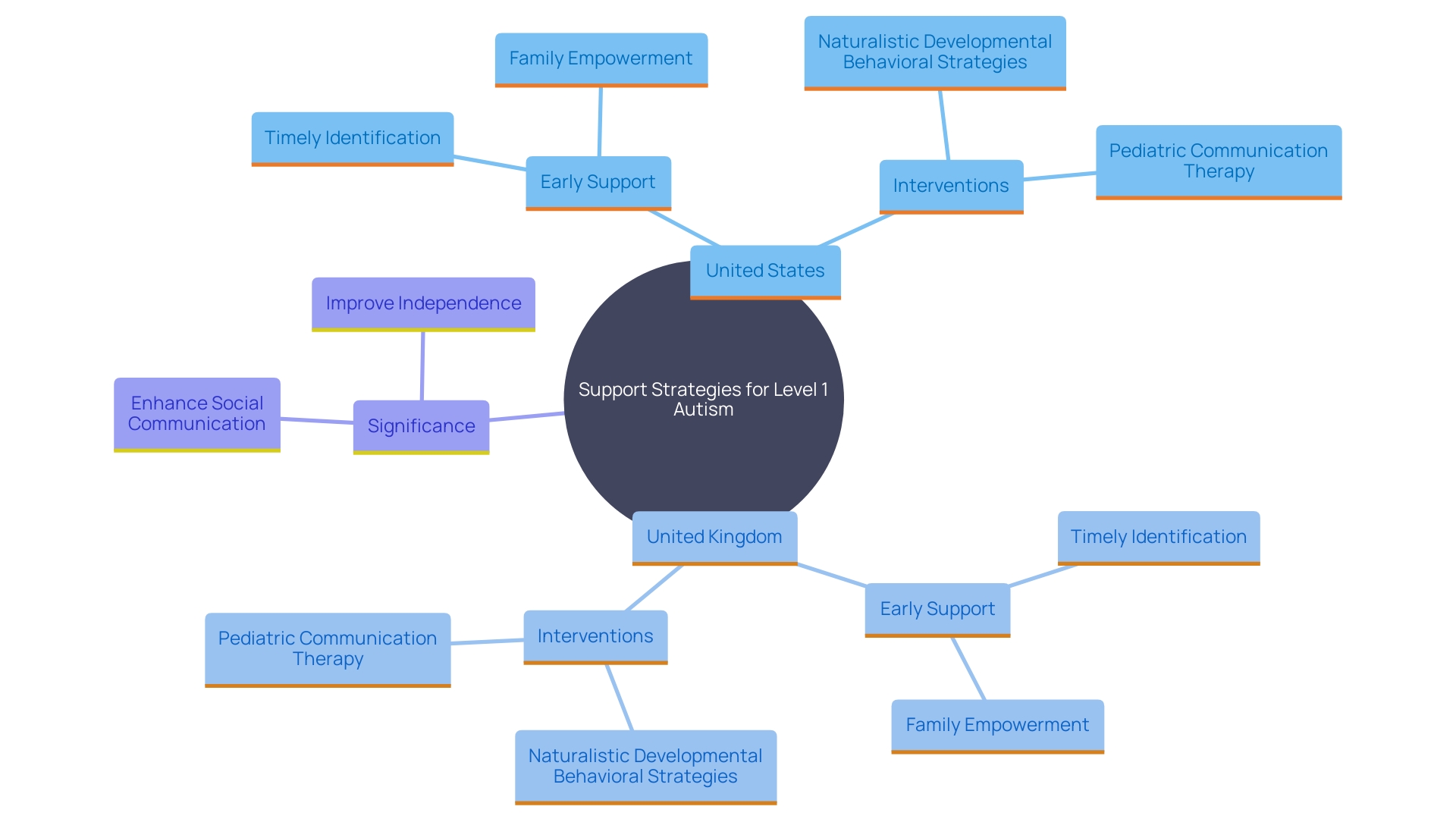
Level 2 Autism: Requiring Moderate Support
Level 2 Autism encompasses individuals who require moderate support in their daily activities. These individuals often display more pronounced communication difficulties, affecting their ability to participate in typical interactions. They frequently struggle with changes in routine, which can lead to heightened anxiety and behavioral challenges. Organized settings and customized strategies are essential to meet their specific requirements.
Approaches like developmental and naturalistic developmental behavioral techniques have been demonstrated to greatly enhance fundamental difficulties related to developmental disorders, especially in communication with others. These measures, when applied effectively, can promote significant advancement. Evidence indicates that early, developmentally suitable, and family-empowering interventions that directly tackle the fundamental challenges of autism are especially advantageous.
Support systems, including therapy and interpersonal skills training, play a pivotal role in enhancing the quality of life for individuals with Level 2 Autism. These systems not only offer the essential tools for improved community interaction but also reduce stress for families. Research indicates that social support, peer support, and hope are essential strategies that help families cope with the demands of ASD, promoting family well-being and reducing collective stress.
Furthermore, recent studies emphasize the significance of early action. For example, intensive behavioral approaches have shown promising outcomes in enhancing communication skills among young autistic children. These approaches are designed to be playful and engaging, making them more effective in addressing the unique attentional preferences of autistic children.
In summary, individuals with Level 2 Autism benefit greatly from structured and personalized assistance systems. By concentrating on customized approaches and strong assistance systems, we can greatly enhance their communication abilities and overall well-being, while also offering vital relief and help to their families.
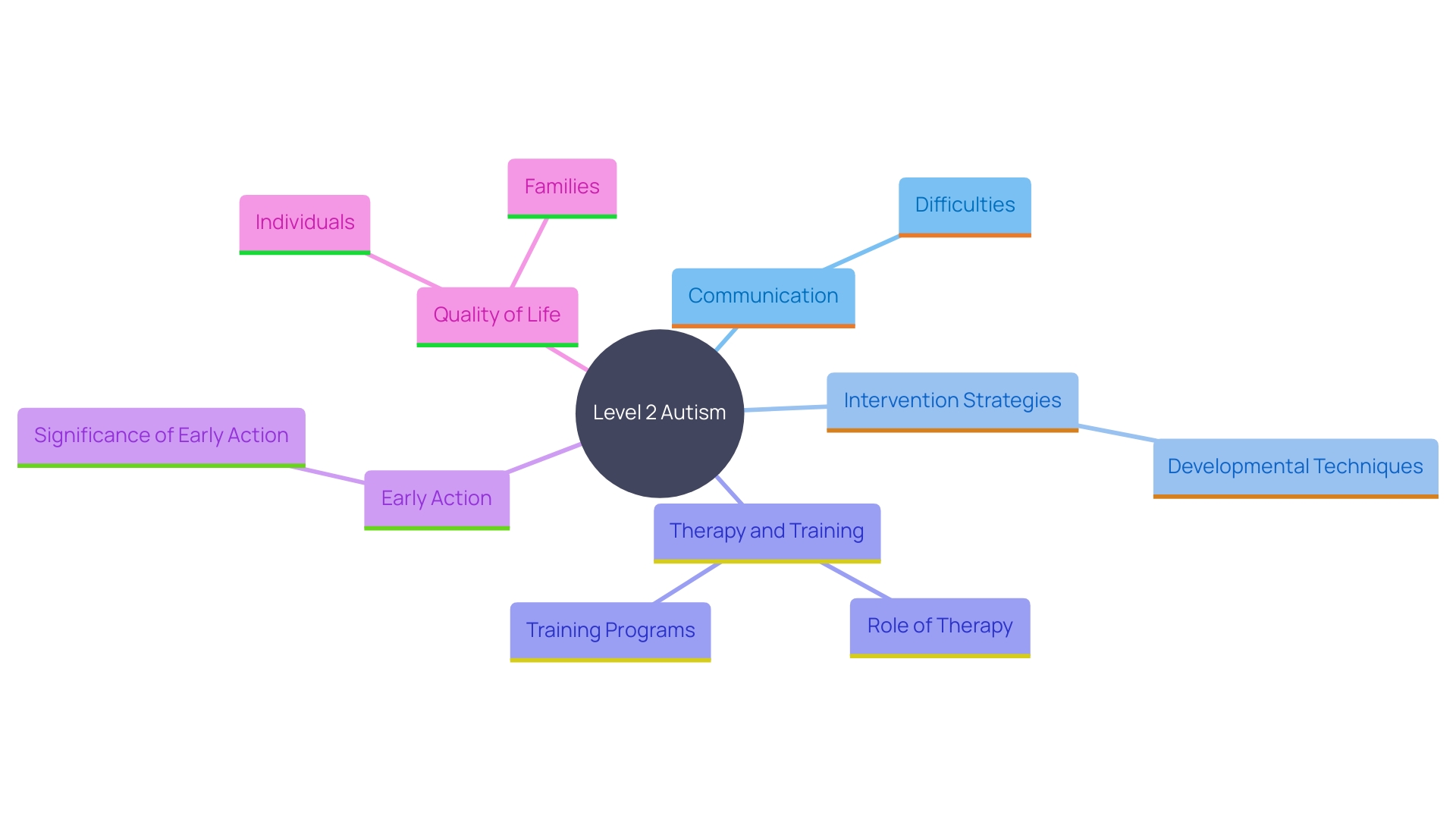
Level 3 Autism: Requiring Very Substantial Support
Individuals classified as Level 3 Autism face significant difficulties and require considerable assistance across multiple areas of their lives. Communication difficulties are severe, often accompanied by repetitive behaviors, making daily functioning a significant hurdle. These individuals require comprehensive assistance to navigate their routines and achieve a semblance of independence. 'Timely assistance is essential, as evidence indicates that developmental interventions can significantly enhance communication abilities, especially when including caregivers in the process.'. A strong assistance network is essential, not only to enhance the individual's abilities but also to alleviate the immense stress experienced by families. According to studies, families of children with developmental disorders often face financial strain, anxiety about the child's future, and a lack of social assistance, which can lead to a high care burden, especially on mothers. The significance of early, personalized interventions and ongoing assistance cannot be overstated, as these measures significantly contribute to the overall well-being and development of individuals with Level 3 Autism.
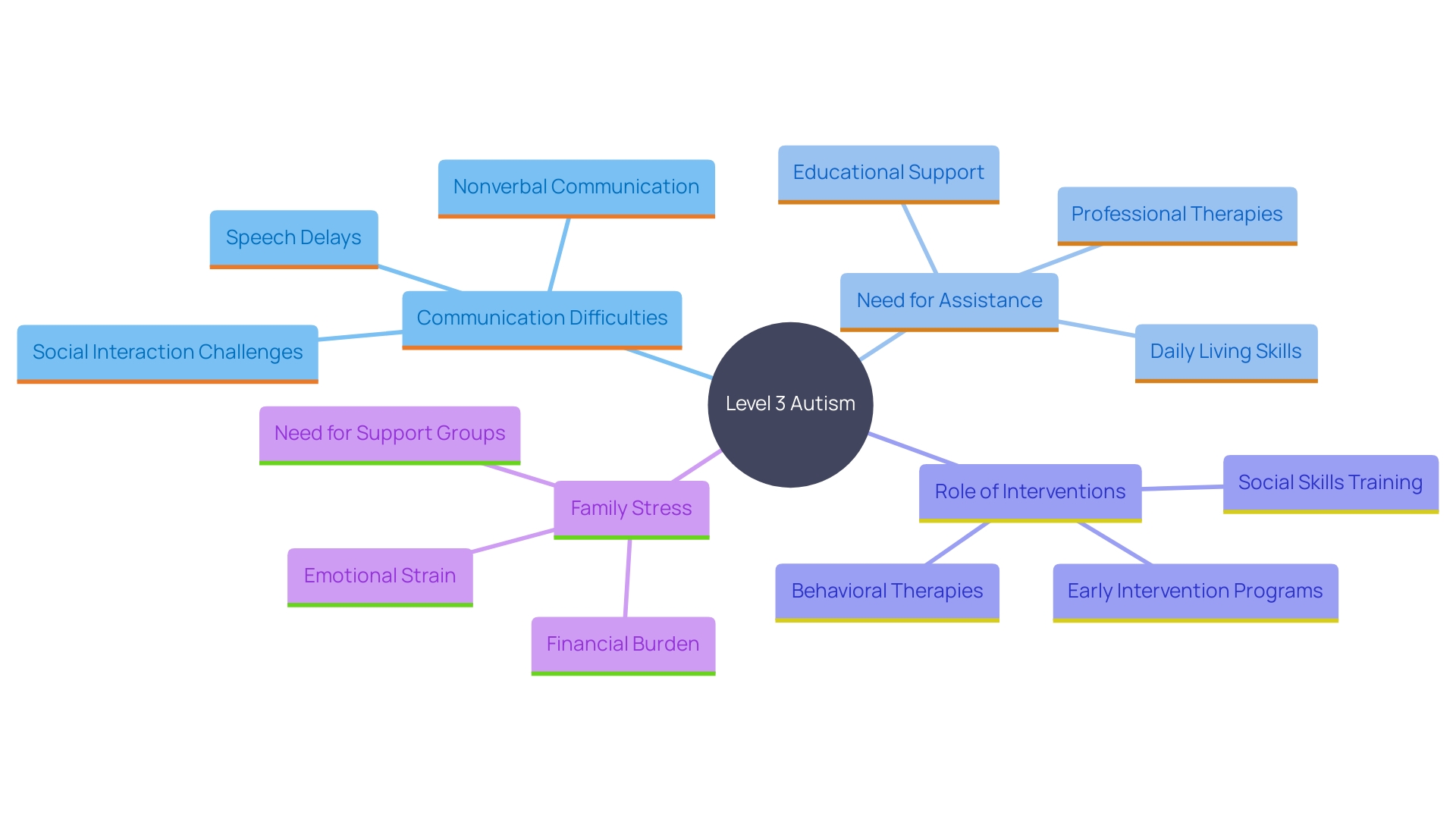
Key Characteristics and Support Needs Across Levels
Each level of autism presents distinct characteristics and assistance needs. Individuals at Level 1 may have less noticeable challenges and often require minimal assistance to function in daily life. Conversely, individuals at Level 3 encounter significant challenges in communication, social interactions, and daily activities, requiring considerable assistance and guidance. Identifying these distinctions is essential for parents and caregivers, as it directs them in personalizing their methods and strategies to address each child's individual needs.
Research highlights the effectiveness of early childhood programs in promoting developmental gains for young autistic children. For instance, early intensive behavioral support (EIBI) in the United States is recommended at an intensity of 20-40 hours per week, targeting functional skills through operant conditioning. On the other hand, the National Institute for Health and Care Excellence in England endorses lower-intensity methods such as pediatric communication therapy and JASPER, which emphasize interaction within natural exchanges.
Moreover, research indicates that developmental programs improve social interaction between children and caregivers and tackle fundamental issues related to the condition. However, it is essential to monitor these measures closely to mitigate any potential adverse effects. Recent findings highlight that even nonspeaking autistic individuals possess a higher understanding of written language conventions than previously estimated, suggesting alternative avenues for communication and engagement.
Therefore, understanding the specific needs and capabilities at each spectrum level allows for more effective, tailored support that fosters growth and development, ultimately improving the quality of life for individuals on the spectrum and their families.
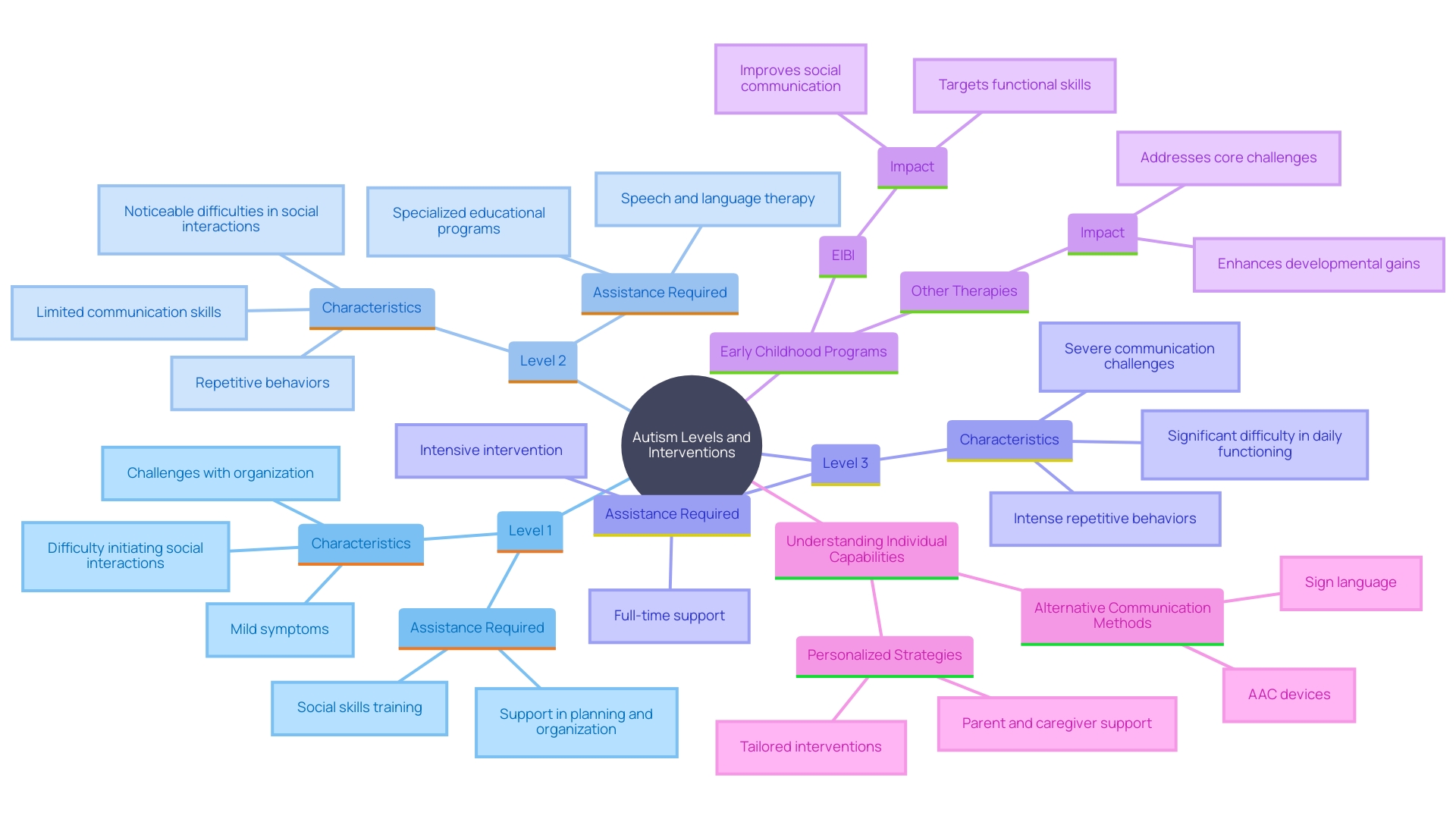
Importance of Early Diagnosis and Personalized Interventions
Prompt identification of the condition is essential, as it enables timely and tailored interventions that address each child's individual requirements. According to the Centers for Disease Control and Prevention, nearly 3% of children in the United States are diagnosed with a developmental disorder. However, the demand for developmental disorder assessments surpasses the capacity of trained specialists, leading to prolonged wait times for families. A study by researchers at Indiana University and Purdue University, published in JAMA Network Open, explored the use of eye tracking biomarkers to expedite autism diagnosis at primary care clinics.
Interventions early in a child's life can significantly enhance social communication and reduce challenging behaviors. For instance, early intensive behavioral support (EIBI) is frequently suggested in the United States, offering 20-40 hours of individual assistance each week. Despite its intensity, EIBI has shown to be effective in promoting skill gains and long-term positive outcomes. However, experts like Micheal Sandbank, PhD, from the UNC School of Medicine, caution that many studies on early actions are of low quality, and there is a need for better monitoring of potential adverse effects.
Research also highlights the benefits of low-intensity, developmentally-informed approaches. A study involving low-intensity programs (2-3 hours per week) found that children showed significant improvements in language use and engagement with their parents, compared to a control group. These findings emphasize the significance of customized approaches that can be effortlessly incorporated into everyday family practices.
By acknowledging the stages of developmental disorders and implementing appropriate interventions, families can create supportive environments where their children can thrive. Customized methods not only tackle the fundamental issues related to developmental disorders but also enable families to offer the essential assistance for their children's growth.
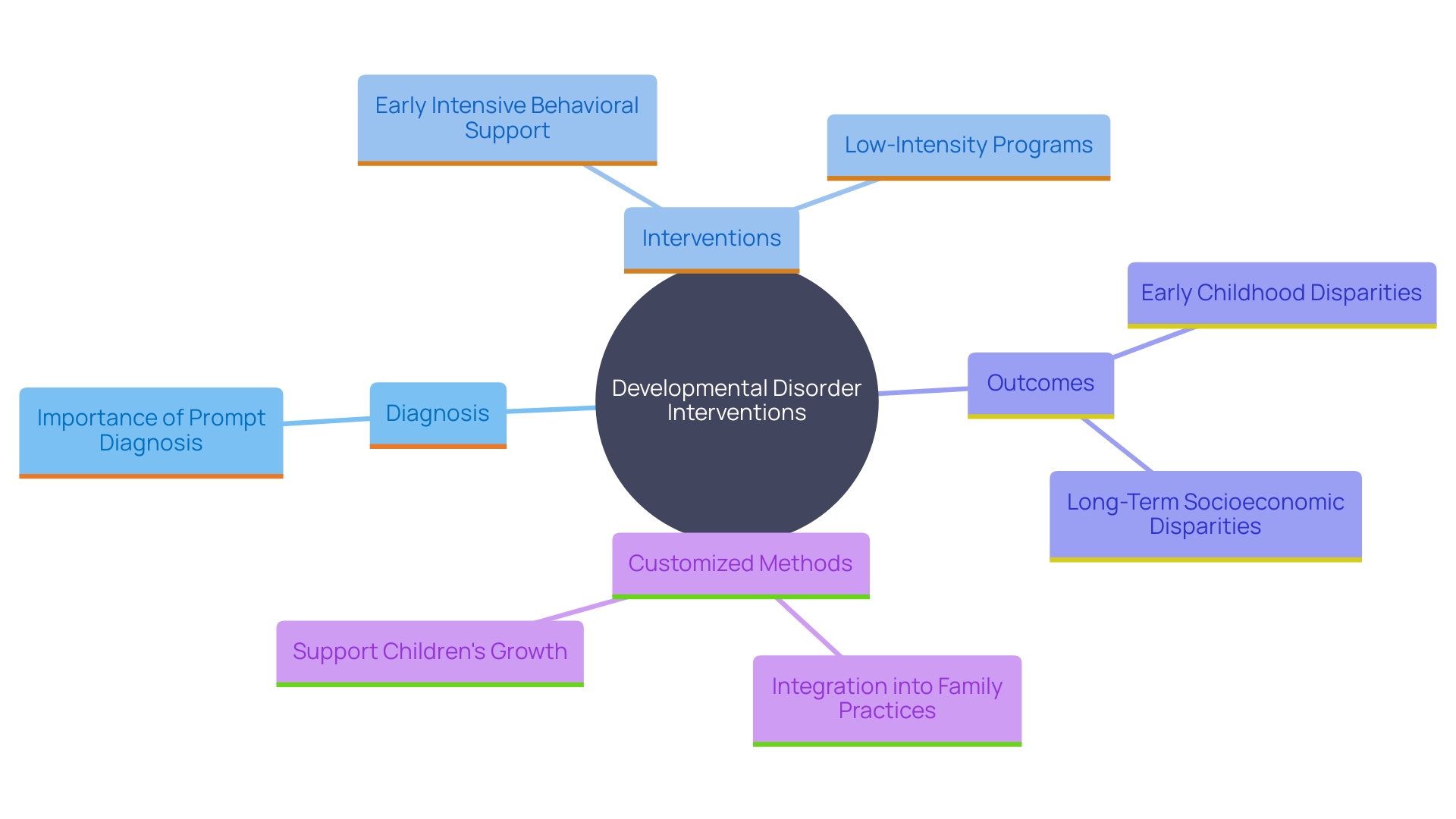
Outlook and Quality of Life Across Different Levels of Autism
The prognosis for individuals on the spectrum can differ significantly based on their degree of assistance requirements. With the right interventions, many individuals can achieve a high quality of life, develop meaningful relationships, and engage in fulfilling activities. 'According to a recent research and advocacy project backed by the Community Foundation for Northern Ireland, securing appropriate resources and assistance for children with autism remains a significant challenge for many parents.'. The study emphasized that 83% of parents did not have access to ASD-friendly assistance resources within their community, often due to barriers such as distance, lack of transport, and the absence of childminding services.
Moreover, the postponement in securing a diagnosis can hinder children from obtaining essential educational placements and assistance services. Parents described how their children faced bullying and ostracism in school, which negatively impacted their mental wellbeing. This lack of support often results in parents feeling overwhelmed and anxious, with many having to rely on charity and voluntary support, which is also diminishing due to funding cuts.
In spite of these difficulties, proof indicates that early childhood programs can greatly enhance social communication and other fundamental issues related to developmental disorders. Naturalistic developmental behavioral approaches, for example, have been found to be particularly effective. It is crucial to identify the particular requirements and difficulties at every phase of the condition to offer customized assistance and interventions. This approach guarantees that children with developmental disorders obtain the essential resources to achieve their full potential, while also aiding the wellbeing of their parents and caregivers.
By understanding and addressing these challenges, parents and caregivers can advocate more effectively for their children, ensuring they receive the comprehensive assistance needed to thrive. Additionally, improving the understanding of neurodiversity in schools and increasing support for voluntary sectors can further enhance the quality of life for individuals with autism and their families.
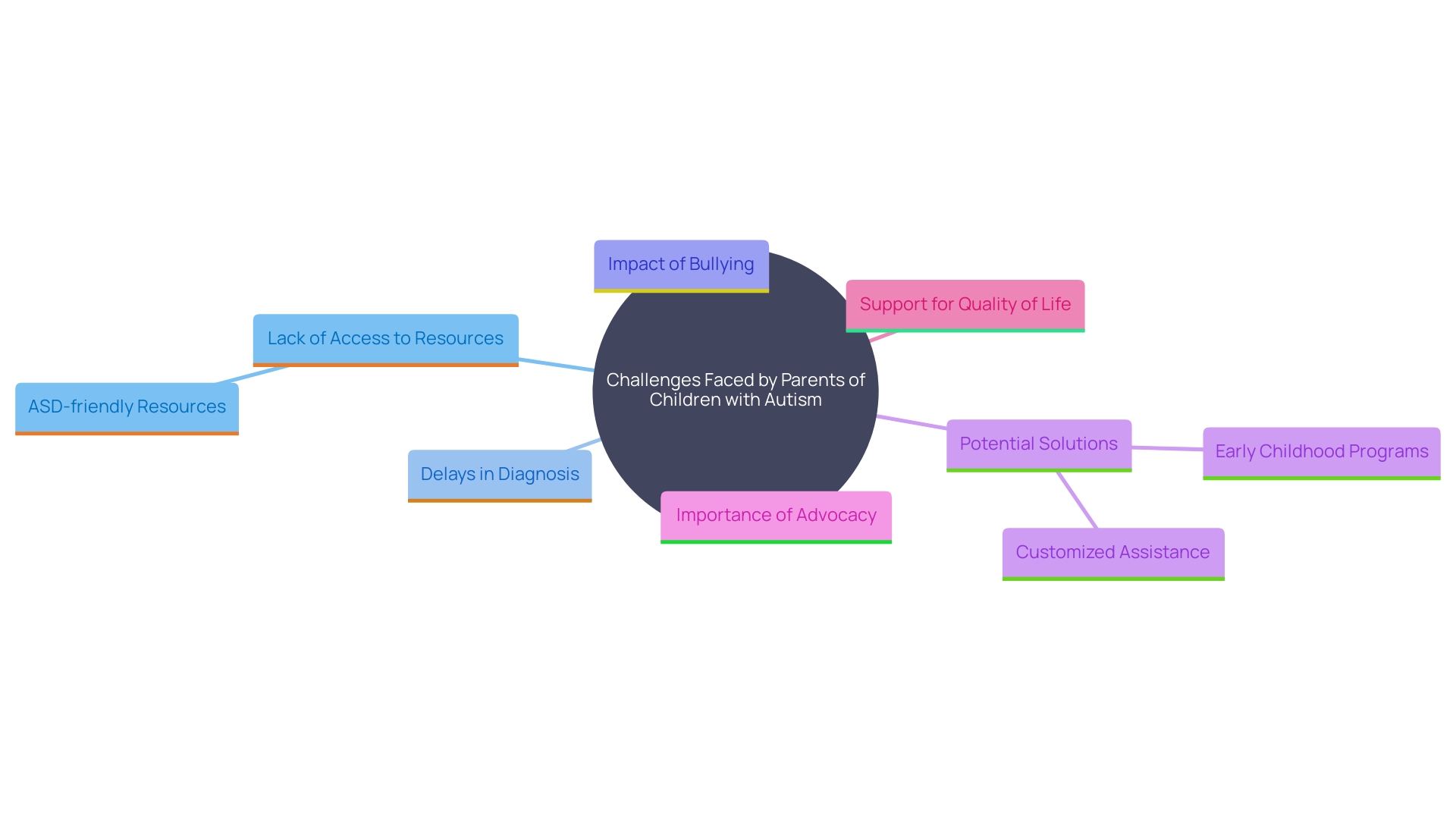
Conclusion
The understanding of autism has progressed significantly, moving from early misconceptions to a nuanced recognition of its complexity as a spectrum disorder. This classification into three levels of support needs is crucial for tailoring effective interventions, empowering parents and caregivers to address their children's unique challenges.
Early diagnosis and personalized interventions are vital for enhancing the quality of life for individuals with autism. Timely support, such as Applied Behavior Analysis (ABA), has proven effective in improving social communication skills. Integrating these interventions into daily routines creates natural learning environments that align with the specific needs of autistic individuals.
Despite these advancements, many families still face barriers, including limited access to specialized services and societal misconceptions. These challenges highlight the ongoing need for advocacy and improved resource allocation. A deeper understanding of autism's varying support needs can help communities foster inclusive environments that empower individuals with autism to thrive.
In conclusion, recognizing the distinct characteristics of each autism level and advocating for comprehensive support systems is essential. By prioritizing early intervention and tailored strategies, families can significantly improve developmental outcomes for their children while also supporting their own well-being. This journey, approached with knowledge and compassion, promises a brighter future for individuals with autism and their families, ensuring they have the necessary tools and support to succeed.




